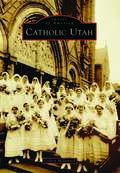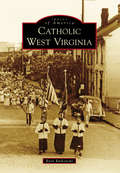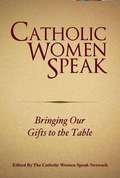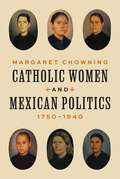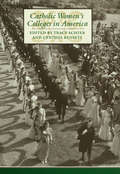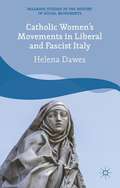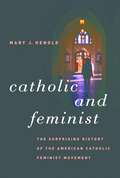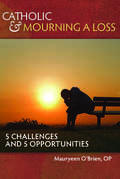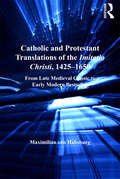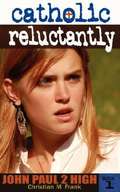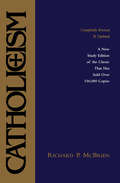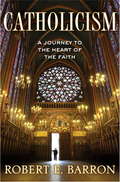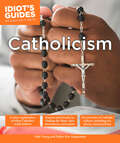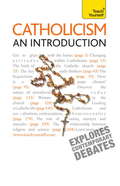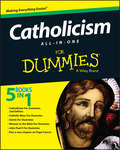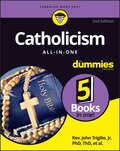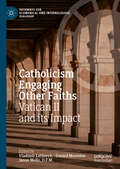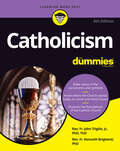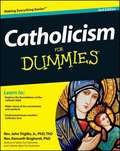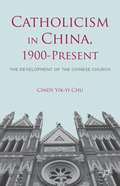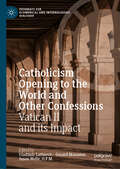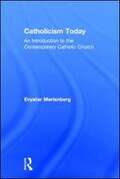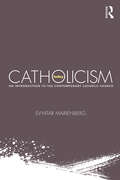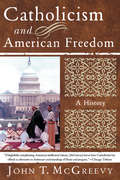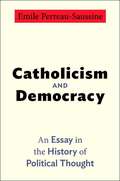- Table View
- List View
Catholic Utah (Images of America)
by Colleen McDannellIn 1776, two Mexican Franciscans trekked into what is now the state of Utah. While they said the rosary and offered litanies to the saints, they did not linger in what was to them unknown territory. It would take almost 100 years for the first parish church of St. Mary Magdalene to be built in 1871 and a Catholic community established. The small number of Catholics maintained and cultivated their religion in a territory dominated by the Latter-day Saints by building churches, starting schools, and maintaining hospitals. Key to their success was the leadership of Fr. Lawrence Scanlan, who served for 42 years, first as pastor and then as bishop. Scanlan ministered to a multiethnic array of Irish, Italian, Slovak, and Mexican Catholics who came to work in and support the dangerous (but lucrative) mining industry. Utah's population expanded after World War II, and Catholic educational and medical institutions increasingly cared for the growing needs of the state.
Catholic West Virginia
by Ryan RutkowskiOvercoming its tumultuous beginnings, the Roman Catholic Diocese of Wheeling-Charleston has matured into a distinguished and active voice for West Virginians. One of the most unique aspects of the diocese's 160-year history is the diversity of the landscape, culture, ethnicity, and dialect that characterizes the state's identity. From Wheeling to Beckley and Martinsburg to Parkersburg, the story of our diocese comes from the individuals who established and nurtured the Catholic faith in their local communities. Without generations of the dedicated faithful, the diocese would not have thrived. Through a variety of images, this book tells the story of the generations that continued striving to give a voice to this unique Catholic community. In addition, professional researchers and local readers alike will find this volume's rare perspective of history through the lived experience of the subjects refreshing.
Catholic Women Speak: Bringing Our Gifts to the Table
by Catholic Women Speak NetworkFrom today's leading theologians, a collection of the serious issues the Church faces related to the family.
Catholic Women and Mexican Politics, 1750–1940
by Margaret ChowningHow women preserved the power of the Catholic Church in Mexican political lifeWhat accounts for the enduring power of the Catholic Church, which withstood widespread and sustained anticlerical opposition in Mexico? Margaret Chowning locates an answer in the untold story of how the Mexican Catholic church in the nineteenth century excluded, then accepted, and then came to depend on women as leaders in church organizations.But much more than a study of women and the church or the feminization of piety, the book links new female lay associations beginning in the 1840s to the surprisingly early politicization of Catholic women in Mexico. Drawing on a wealth of archival materials spanning more than a century of Mexican political life, Chowning boldly argues that Catholic women played a vital role in the church’s resurrection as a political force in Mexico after liberal policies left it for dead.Shedding light on the importance of informal political power, this book places Catholic women at the forefront of Mexican conservatism and shows how they kept loyalty to the church strong when the church itself was weak.
Catholic Women's Colleges in America
by Tracy Schier and Cynthia RussettMore than 150 colleges in the United States were founded by nuns, and over time they have served many constituencies, setting some educational trends while reflecting others. In Catholic Women's Colleges in America, Tracy Schier, Cynthia Russett, and their coauthors provide a comprehensive history of these institutions and how they met the challenges of broader educational change. The authors explore how and for whom the colleges were founded and the role of Catholic nuns in their founding and development. They examine the roots of the founders' spirituality and education; they discuss curricula, administration, and student life. And they describe the changes prompted by both the church and society beginning in the 1960s, when decreasing enrollments led some colleges to opt for coeducation, while others restructured their curricula, partnered with other Catholic colleges, developed specialized programs, or sought to broaden their base of funding.Contributors: Dorothy M. Brown, Georgetown University; David R. Contosta, Chestnut Hill College; Jill Ker Conway, Massachusetts Institute of Technology; Carol Hurd Green, Boston College; Monika K. Hellwig, Association of Catholic Colleges and Universities; Karen Kennelly, president emerita of Mount Saint Mary's College, Los Angeles; Jeanne Knoerle, president emerita of Saint Mary-of-the-Woods College; Thomas M. Landy, College of the Holy Cross; Kathleen A. Mahoney, Humanitas Foundation; Melanie M. Morey, Leadership and Legacy Associates, Boston; Mary J. Oates, Regis College; Jane C. Redmont, Graduate Theological Union in Berkeley; Cynthia Russett, Yale University; Tracy Schier, Boston College.
Catholic Women�s Movements in Liberal and Fascist Italy
by Helena DawesIn the early 1900s the Catholic Church appealed, for the first time in its history, directly to women to reassert its religious, political and social relevance in Italian society. This book examines how the highly successful conservative Catholic women's movements that followed, and how they mobilized women against secular feminism.
Catholic and Feminist
by Mary J. HenoldIn 1963, as Betty Friedan's Feminine Mystique appeared and civil rights activists marched on Washington, a separate but related social movement emerged among American Catholics, says Mary Henold. Thousands of Catholic feminists--both lay women and women religious--marched, strategized, theologized, and prayed together, building sisterhood and confronting sexism in the Roman Catholic Church. In the first history of American Catholic feminism, Henold explores the movement from the 1960s through the early 1980s, showing that although Catholic feminists had much in common with their sisters in the larger American feminist movement, Catholic feminism was distinct and had not been simply imported from outside. Catholic feminism grew from within the church, rooted in women's own experiences of Catholicism and religious practice, Henold argues. She identifies the Second Vatican Council (1962-65), an inspiring but overtly sexist event that enraged and exhilarated Catholic women in equal measure, as a catalyst of the movement within the church. Catholic feminists regularly explained their feminism in terms of their commitment to a gospel mandate for social justice, liberation, and radical equality. They considered feminism to be a Christian principle. Yet as Catholic feminists confronted sexism in the church and the world, Henold explains, they struggled to integrate the two parts of their self-definition. Both Catholic culture and feminist culture indicated that such a conjunction was unlikely, if not impossible. Henold demonstrates that efforts to reconcile faith and feminism reveal both the complex nature of feminist consciousness and the creative potential of religious feminism.
Catholic and Mourning a Loss: 5 Challenges and 5 Opportunities
by Mauryeen Op5 Challenges - Our ability to work through the grieving process will be tested - Our life will be changed because of our loss - Our ability to function will be questioned - Our dreams for the future may have to be altered - We will question our reliance on other and even on God 5 Opportunities - We can learn to use the gifts that working through grief has offered us - We can realize that change can be an opportunity for newness and growth - We can explore the new-found strength that can be ours - We can go beyond ourselves as we face the future - We will be able to "let go and let God" be in control
Catholic and Protestant Translations of the Imitatio Christi, 1425–1650: From Late Medieval Classic to Early Modern Bestseller (St Andrews Studies In Reformation History Ser.)
by Maximilian von HabsburgThe Imitatio Christi is considered one of the classic texts of Western spirituality. There were 800 manuscript copies and more than 740 different printed editions of the Imitatio between its composition in the fifteenth century and 1650. During the Reformation period, the book retained its popularity with both Protestants and Catholics; with the exception of the Bible it was the most frequently printed book of the sixteenth century. In this pioneering study, the remarkable longevity of the Imitatio across geographical, chronological, linguistic and confessional boundaries is explored. Rather than attributing this enduring popularity to any particular quality of universality, this study suggests that its key virtue was its appropriation by different interest groups. That such an apparently Catholic and monastic work could be adopted and adapted by both Protestant reformers and Catholic activists (including the Jesuits) poses intriguing questions about our understanding of Reformation and Counter Reformation theology and confessional politics. This study focuses on the editions of the Imitatio printed in English, French, German and Latin between the 1470s and 1650. It offers an ambitious and comprehensive survey of the process of translation and its impact and contribution to religious culture. In so doing it offers a fresh analysis of spirituality and devotion within their proper late medieval and early modern contexts. It also demonstrates that spirituality was not a peripheral dimension of religion, but remains at the very heart of both Catholic and Protestant self-perception and identity.
Catholic, Reluctantly (John Paul 2 High #1)
by Christian M. FrankThe seven students of a newly-established Catholic high school try to learn and do what is right. As they face the possibility that their building will be condemned, personality conflicts, and problems with the nearby public high school, where two of them are on the wrestling team.
Catholicism
by Richard P. McbrienRevised and updated edition of a religious guide originally published in 1980. Provides an overview of the Catholic Church's teachings and beliefs, including its doctrines, history, biblical origins, theological and moral thinking and recent developments including the contribution of feminism, the rise of liberation theology and Christian reflection on the economy. References have also been added throughout to the new TCatechism of the Catholic Church'. Also available in hardback. The author is professor of theology and former chairman of the department of theology at Notre Dame University, USA.
Catholicism
by Robert Barron"What I propose to do in this book is to take you on a guided exploration of the Catholic world, but not in the manner of a docent, for I am not interested in showing you the artifacts of Catholicism as though they were dusty objets d'art in a museum of culture. I want to function rather as a mystagogue, conducting you ever deeper into the mystery of the incarnation in the hopes that you might be transformed by its power." -Father Robert Barron What is the Catholicism? A 2,000 living tradition? A worldview? A way of life? A relationship? A mystery? In Catholicism Father Robert Barron examines all these questions and more, seeking to capture the body, heart and mind of the Catholic faith. Starting from the essential foundation of Jesus Christ's incarnation, life, and teaching, Father Barron moves through the defining elements of Catholicism - from sacraments, worship, and prayer, to Mary, the Apostles, and Saints, to grace, salvation, heaven, and hell - using his distinct and dynamic grasp of art, literature, architecture, personal stories, Scripture, theology, philosophy, and history to present the Church to the world. Paired with his documentary film series of the same title, Catholicism is an intimate journey, capturing "The Catholic Thing" in all its depth and beauty. Eclectic, unique, and inspiring, Father Barron brings the faith to life for a new generation, in a style that is both faithful to timeless truths, while simultaneously speaking in the language of contemporary life.Includes over 100 black and white and color photos.From the Hardcover edition.
Catholicism (Idiot's Guides)
by Julie Young Eric AugensteinMore than 1.2 billion people in the world identify as "Catholic." People outside this ancient faith sometimes have trouble comprehending its structure, values, traditions, and beliefs. Idiot's Guides: Catholicism is for any new — or renewed — believer. This thorough guide covers everything from the foundational tenets and creeds, the visible signs of Catholicism, and an explanation of specific prayers. An exploration of the Mass, holy days, key people and places, art, literature, and more are also covered in easy-to-understand text.
Catholicism - An Introduction: Teach Yourself (TY Religion)
by Peter StanfordThis is a complete guide to the oldest institution in the Western world - the Catholic Church. Explore the essential beliefs and practices of the religion and delve into its long and fascinating history. From the significance of Rome and the importance of the Papacy, to current issues such as science, contraception and new movements within the faith, learn what it means to be Catholic today. NOT GOT MUCH TIME? One, five and ten-minute introductions to key principles to get you started. AUTHOR INSIGHTS Lots of instant help with common problems and quick tips for success, based on the author's many years of experience. TEST YOURSELF Tests in the book and online to keep track of your progress. EXTEND YOUR KNOWLEDGE Extra online articles at www.teachyourself.com to give you a richer understanding of psychology. FIVE THINGS TO REMEMBER Quick refreshers to help you remember the key facts. TRY THIS Innovative exercises illustrate what you've learnt and how to use it.
Catholicism All-In-One For Dummies
by Consumer DummiesGrasp the beliefs and practices about one of the world's oldest religions Catholicism All-In-One For Dummies is your all-inclusive guide to the Catholic Church and its billions of followers. You'll learn how Catholicism came to be, how it's practiced, and where it stands socially and politically as you explore the rich history and diverse culture surrounding this major religion. Clear, friendly writing takes you inside a mass to understand what happens there, and walks you through a tour of the saints, holidays, the Bible, and the Vatican. Special coverage includes the role of women in the Church and in the Bible, and the tremendous popularity of Pope Francis, who has quickly become one of the Vatican's most-loved leaders. You'll dive into the beliefs and practices of Catholicism and get answers to the most common, confusing, controversial, and worrisome questions. Catholicism is quickly expanding beyond its 1.2 billion followers, with growing numbers of priests and new baptisms every year. Attendance at papal events has tripled to 6.6 million since Pope Francis' election in 2013, and Catholicism has become the largest religious denomination on the planet by a wide margin. This book explains what makes Catholicism so alluring, giving you insight into the religion and everything it entails. Discover the complicated history of the Catholic church Understand what goes on at mass, and why Learn where the Church stands on important issues Explore Pope Francis's unprecedented popularity across cultures The Catholic Church has been reinvigorated and revitalized with the enthusiasm surrounding Pope Francis, and his openness to the world and everyone in it. If your curiosity has been piqued, Catholicism All-In-One For Dummies is the ideal guide to learning what it's all about.
Catholicism All-in-One For Dummies
by Annie Sullivan Rev. John Trigilio Jr. Rev. Kenneth Brighenti Rev. Jonathan Toborowsky Rev. Monsignor James CafoneLet there be light—illuminating info about today’s Catholic church Catholicism All-in-One For Dummies offers a path toward understanding the beliefs of the Catholic church and how the church operates. Fully updated with information on newly canonized saints, updated teachings from Pope Francis, and how Catholic beliefs intersect with the modern world, this edition gets you up to date with the last 2000 or so years or Catholic history. With five minibooks in one, this friendly Dummies guide will answer your pressing questions. What do Catholics believe? What happens in Mass? Who are the saints? What is the role of the Pope? And other cool stuff you’ve been wanting to know about this Christianity denomination with over one billion members worldwide. Discover the core tenets of the Catholic religion Learn all about the papacy and get to know Pope Francis Get a primer on the Catholic saints, including those newly canonized Walk through the traditions of Mass and the seven sacramentsThis is an excellent resource for anyone who needs a clear guide to the practices and rules of the Catholic faith and wants a fascinating look into a prominent world religion.
Catholicism Engaging Other Faiths: Vatican Ii And Its Impact (Pathways For Ecumenical And Interreligious Dialogue Ser.)
by Gerard Mannion Vladimir Latinovic Jason Welle, O.F.M.This book assesses how Vatican II opened up the Catholic Church to encounter, dialogue, and engagement with other world religions. Opening with a contribution from the President of the Pontifical Council for Interreligious Dialogue, Cardinal Jean-Louis Tauran, it next explores the impact, relevance, and promise of the Declaration Nostra Aetate before turning to consider how Vatican II in general has influenced interfaith dialogue and the intellectual and comparative study of world religions in the postconciliar decades, as well as the contribution of particular past and present thinkers to the formation of current interreligious and comparative theological methods. Additionally, chapters consider interreligious dialogue vis-à-vis theological anthropology in conciliar documents; openness to the spiritual practices of other faith traditions as a way of encouraging positive interreligious encounter; the role of lay and new ecclesial movements in interreligious dialogue; and the development of Monastic Interreligious Dialogue. Finally, it includes a range of perspectives on the fruits and future of Vatican’s II’s opening to particular faiths such as Judaism, Islam, Hinduism, and Buddhism.
Catholicism For Dummies
by Rev. Kenneth Brighenti TrigilioPeer through the stained glass and get an inside look at Christianity's most popular religion Catholicism can seem a bit mysterious to non-Catholics—and even Catholics. Embrace your curiosity and turn to Dummies for answers! Full of fascinating facts and written in a friendly style, Catholicism For Dummies explains the basics of Catholic beliefs like the importance of Sunday Mass; the seven sacraments; the purity of the Blessed Virgin Mary; heaven, hell, and purgatory; the Trinity; and so much more. You'll learn about the Catholic perspective on women as priests, saints as examples of how to live, and prayer as the basis of a relationship with God. This easy-to-read resource offers an overview of a rich and diverse faith. You'll also discover: The ins and outs of living as a Catholic and why followers of the faith observe traditions like attending Mass on certain days of the year, praying the rosary, and not eating meat on Fridays Information on what the pope does, how he is selected, the history of the Vatican, and what it's like to be a priest in today's society Details about the church's position on modern social issues, like poverty, abortion and the death penalty, same-sex marriage, and contraception Whether you're a cradle Catholic or just curious about the world's second largest religion, Catholicism For Dummies has the answers you're seeking to a faith that's been around for thousands of years. Order your copy today.
Catholicism For Dummies, 2nd Edition
by Rev Kenneth Brighenti Rev John TrigilioThe easy way to grasp the ins and outs of Catholicism Catholicism For Dummies is not a catechism or religious textbook, but a casual, down-to-earth introduction for Catholics and non-Catholics. It gives commonsense explanations of Catholic weddings, Baptisms, funerals, Confirmations, and First Communions. You'll also discover other important topics that can help you better understand the Catholic culture--from morality and devotions to worship and liturgy. There are more than one billion Catholics in the world, and each one shares a foundational set of basic beliefs and practices that he or she follows. Some of the teachings of Catholicism are thousands of years old, while others are more recent. So what is the Catholic culture like and what do they believe? Catholicism For Dummies answers these and many other questions. Various stances within American Catholicism today Covers the death of John Paul II and the succession of Pope Benedict XVI, who has supported the return of the Latin Mass among congregations who desire to celebrate it Expanded information on baptism, confirmation, and the other sacraments New information about the priesthood and religious life today Twenty-first-century issues and questions modern Catholics face, including gay marriage, abortion, and the death penalty Catholicism For Dummies presents a rich tapestry and history of the Catholic faith--from devotions to doctrines. This intelligent and faithful look at Catholicism will open your eyes to this religion and answer many of the questions you may have about it.
Catholicism In China, 1900–present
by Cindy Yik-yi ChuThis volume is the product of scholars of various backgrounds, specialties and agendas bringing forth their most treasured findings regarding the Chinese Catholic Church. The chapters in this book covering the church from 1900 to the present trace the development of the Church in China from many historical and disciplinary vantage points.
Catholicism Opening to the World and Other Confessions: Vatican II and its Impact (Pathways For Ecumenical And Interreligious Dialogue Ser.)
by Gerard Mannion Vladimir Latinovic Jason Welle O.F.M.This volume explores how Catholicism began and continues to open its doors to the wider world and to other confessions in embracing ecumenism, thanks to the vision and legacy of the Second Vatican Council. It explores such themes as the twentieth century context preceding the council; parallels between Vatican II and previous councils; its distinctively pastoral character; the legacy of the council in relation to issues such as church-world dynamics, as well as to ethics, social justice, economic activity. Several chapters discuss the role of women in the church before, during, and since the council. Others discern inculturation in relation to Vatican II. The book also contains a wide and original range of ecumenical considerations of the council, including by and in relation to Free Church, Reformed, Orthodox, and Anglican perspectives. Finally, it considers the Council’s ongoing promise and remaining challenges with regard to ecumenical issues, including a groundbreaking essay on the future of ecumenical dialogue by Cardinal Walter Kasper.
Catholicism Today: An Introduction to the Contemporary Catholic Church
by Evyatar MarienbergCatholics are not Christians. They worship Mary. They do whatever the pope says. They cannot divorce. They eat fish on Fridays. These flawed but common statements reflect a combined ignorance of and fascination with Catholicism and the Catholic Church. <P><P> Catholicism Today: An Introduction to the Contemporary Catholic Church aims to familiarize its readers with contemporary Catholicism. The book is designed to address common misconceptions and frequently-asked questions regarding the Church, its teachings, and the lived experience of Catholics in modern societies worldwide. Opening with a concise historical overview of Christianity in general and Catholicism in particular, the text explores the core beliefs and rituals that define Catholicism in practice, the organization of the Church and the Catholic calendar, as well as the broad question of what it means to be Catholic in a variety of cultural contexts. The book ends with a discussion of the challenges facing the Church both now and in the coming decades. Also included are two short appendices on Eastern Catholicism and Catholicism in the United States.
Catholicism Today: An Introduction to the Contemporary Catholic Church
by Evyatar MarienbergCatholics are not Christians. They worship Mary. They do whatever the pope says. They cannot divorce. They eat fish on Fridays. These flawed but common statements reflect a combined ignorance of and fascination with Catholicism and the Catholic Church. Catholicism Today: An Introduction to the Contemporary Catholic Church aims to familiarize its readers with contemporary Catholicism. The book is designed to address common misconceptions and frequently-asked questions regarding the Church, its teachings, and the lived experience of Catholics in modern societies worldwide. Opening with a concise historical overview of Christianity in general and Catholicism in particular, the text explores the core beliefs and rituals that define Catholicism in practice, the organization of the Church and the Catholic calendar, as well as the broad question of what it means to be Catholic in a variety of cultural contexts. The book ends with a discussion of the challenges facing the Church both now and in the coming decades. Also included are two short appendices on Eastern Catholicism and Catholicism in the United States.
Catholicism and American Freedom: A History
by John T. Mcgreevy"[McGreevy] has written the best intellectual history of the Catholic Church in America."--Commonweal For two centuries, Catholicism has played a profound and largely unexamined role in America's political and intellectual life. Emphasizing the communal over the individual, protections for workers and the poor over market freedoms, and faith in eternal verities over pragmatic compromises, the Catholic worldview has been a constant foil to liberalism. Catholicism and American Freedom is a groundbreaking tale of strange bedfellows and bitter conflicts over issues such as slavery, public education, economic reform, the movies, contraception, and abortion. It is an international story, as both liberals and conservatives were influenced by ideas and events abroad, from the 1848 revolutions to the rise of Fascism and the Spanish Civil War in the 1930s, to papal encyclicals and the Second Vatican Council in the 1960s; and by the people, from scholarly Jesuits to working class Catholics, who immigrated from Europe and Latin America. McGreevy reveals how the individualist, and often vehemently anti-Catholic, inclinations of Protestant intellectuals shaped the debates over slavery--and how Catholics, although they were the first to acknowledge the moral equality of black people and disavowed segregation of churches, even in the South, still had difficulty arguing against the hierarchy and tradition represented by slavery. He sheds light on the unsung heroes of American history like Orestes Browson, editor of Brownson's Quarterly Review, who suffered the disdain of abolitionists for being a Catholic, and the antagonism of conservative Catholics for being an abolitionist; and later heroes like Jacques Maritain and John Courtney Murray, who fought to modernize the Church, increased attention to human rights, and urged the Church "to adapt herself vitally . . . to what is valid in American democratic development." Putting recent scandals in the Church and the media's response in a much larger context, this stimulating history is a model of nuanced scholarship and provocative reading.
Catholicism and Democracy
by Emile Perreau-SaussineCatholicism and Democracy is a history of Catholic political thinking from the French Revolution to the present day. Emile Perreau-Saussine investigates the church's response to liberal democracy, a political system for which the church was utterly unprepared. Looking at leading philosophers and political theologians--among them Joseph de Maistre, Alexis de Tocqueville, and Charles Péguy--Perreau-Saussine shows how the church redefined its relationship to the State in the long wake of the French Revolution. Disenfranchised by the fall of the monarchy, the church in France at first embraced that most conservative of ideologies, "ultramontanism" (an emphasis on the central role of the papacy). Catholics whose church had lost its national status henceforth looked to the papacy for spiritual authority. Perreau-Saussine argues that this move paradoxically combined a fundamental repudiation of the liberal political order with an implicit acknowledgment of one of its core principles, the autonomy of the church from the state. However, as Perreau-Saussine shows, in the context of twentieth-century totalitarianism, the Catholic Church retrieved elements of its Gallican heritage and came to embrace another liberal (and Gallican) principle, the autonomy of the state from the church, for the sake of its corollary, freedom of religion. Perreau-Saussine concludes that Catholics came to terms with liberal democracy, though not without abiding concerns about the potential of that system to compromise freedom of religion in the pursuit of other goals.
